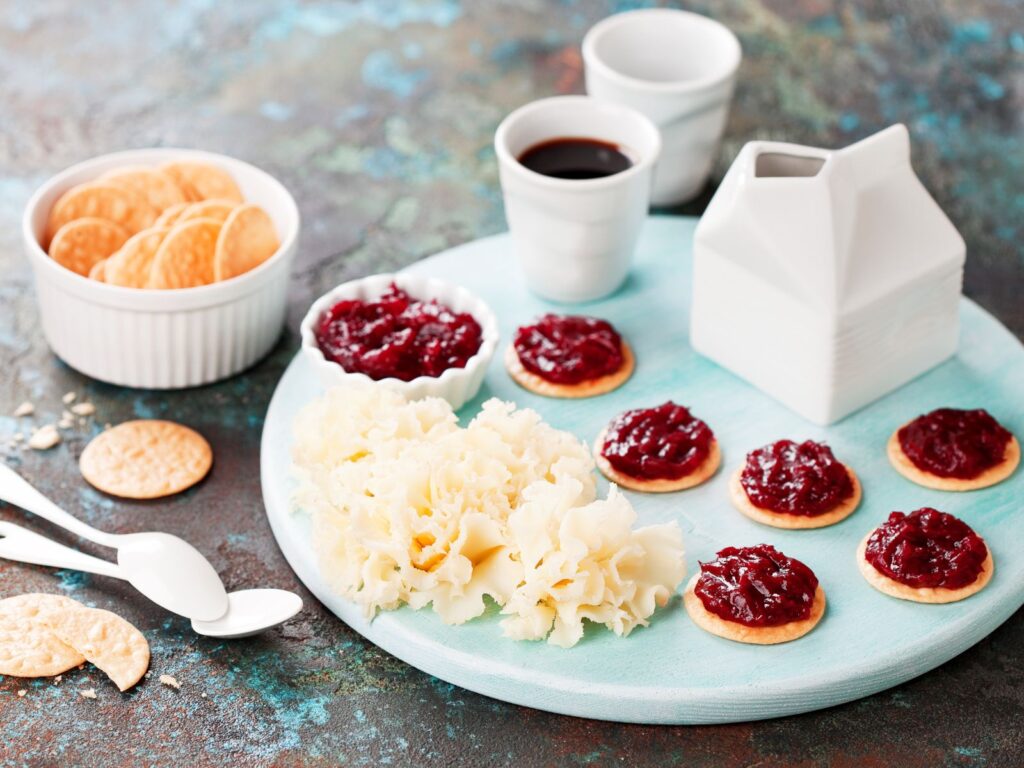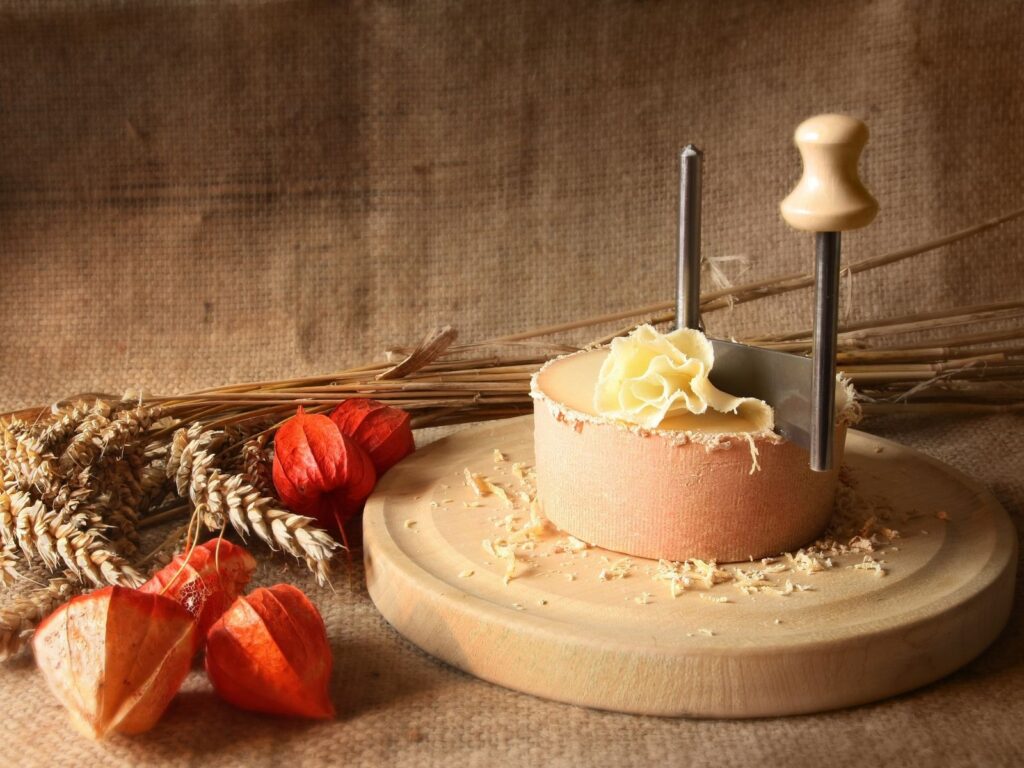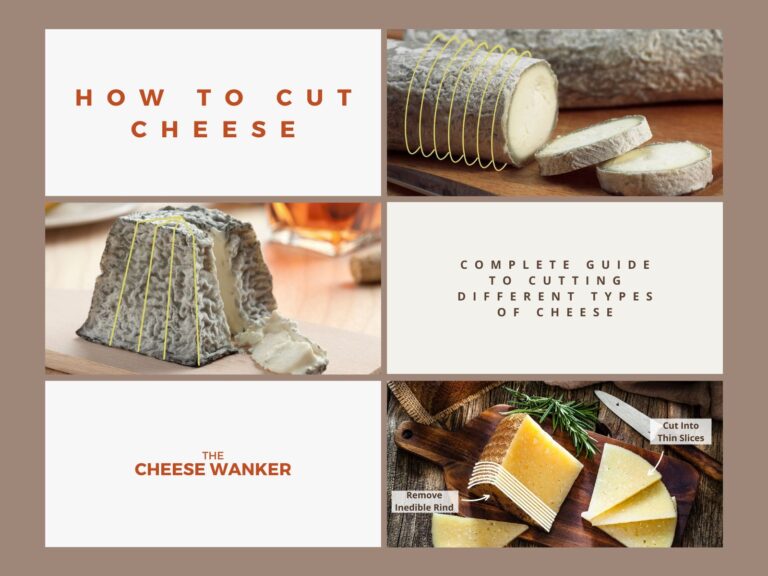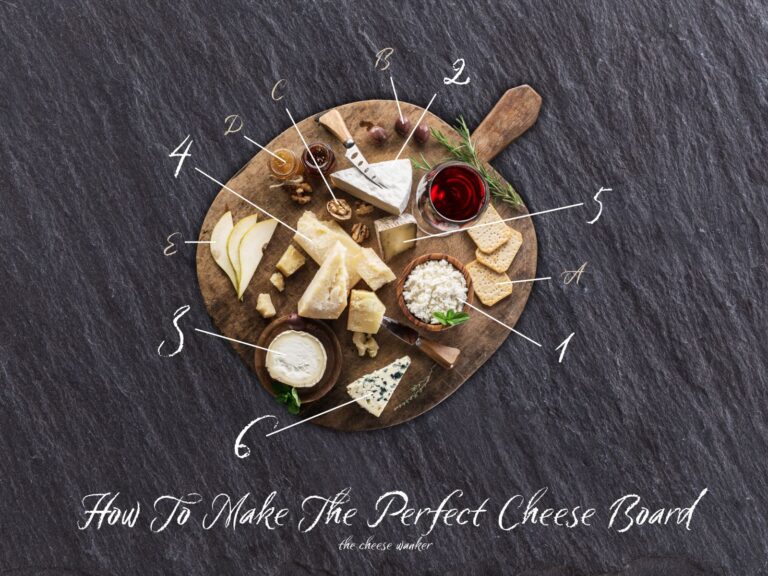Hey, cheese enthusiasts! Gather around because today we’re diving into the delightful world of Tête de Moine cheese. If you’ve ever marveled at those perfect rosettes adorning a cheese platter and wondered how it’s done, you’re in for a treat. This blog post is your backstage pass to mastering the art of cutting Tête de Moine cheese. Grab your knives and let’s get slicing!
BUY NOW: Entertain in style with this awesome Boska Girolle Cheese Curler →
About Tête de Moine
Originating from the Swiss Jura region, Tête de Moine cheese, meaning “Monk’s Head”, is a culinary treasure steeped in history.
Crafted using traditional methods dating back to medieval Swiss monasteries, this cheese embodies centuries of expertise. Its semi-hard, supple texture and earthy, nutty aroma create a delightful sensory experience. When you taste Tête de Moine, you’re met with a harmonious blend of savoury and slightly sweet notes, leaving a lingering richness that is utterly irresistible.
How to serve Tête de Moine

Whether you choose the traditional Girolle or a sharp cheese knife, finesse in your cuts is key. Moreover, serve Tête de Moine at its best by allowing it to reach room temperature, enhancing its full flavour profile.
Pair this exquisite cheese with fresh fruits like pears and grapes for contrast. And add the satisfying crunch of crusty bread or buttery crackers. Elevate the experience with drizzled honey or scattered roasted nuts.
When it comes to beverages, a glass of crisp Chardonnay or a light-bodied Pinot Noir complements Tête de Moine’s richness. Arrange the cheese rosettes or slices in a circular pattern to showcase its unique texture, transforming your cheese platter into a work of art.
Embrace the artful balance of tradition and creativity, and savour every moment of this culinary masterpiece.
What is a Girolle?

Now, onto the tools of the trade. Meet the Girolle, the magician behind those beautiful cheese rosettes. This nifty device consists of a rotating platform and a sharp blade. It’s your ticket to cheese-cutting perfection.
This unique cutting device is a relatively recent Swiss invention that finds it roots in Lajoux in the Swiss Jura region. It was first made in 1982 by Nicolas Crevoisier who wanted to create a tool that could efficiently slice Tête de Moine.
The Girolle consists of two main parts, a circular wooden base and a stainless steel knife with handle that sits on top. The operation is pretty straight forward and, actually, a lot of fun!
Fast forward almost four decades and the Girolle is now synonymous with Tête de Moine. The original makers, Girolle Originale, have sold more than 3 million units worldwide and it is available in all countries where Tête de Moine is exported to.
Step-by-step guide to cutting Tête de Moine cheese
So, now you know that you need a Girolle. But how do you use this wondrous contraption?
- Preparing the cheese: Take your Tête de Moine straight from the fridge. A cold cheese will have a slightly firmer texture which will help with the cutting.
- Cut the cheese wheel in half horizontally: This aligns the cheese with the height of the Girolle. Furthermore, it will allow the blade to go through the exposed paste of the cheese rather than the rind.
- Setting up the Girolle: Assemble your Girolle, ensuring the blade is sharp. Adjust the thickness of the rosettes according to your preference.
- Place the half-wheel of cheese on Girolle: Hold the half-wheel with the uncut rind at the bottom, gently press it onto the metal spike on the Girolle. Slide the cheese all the way down until it lies on the wooden base.
- Using the Girolle: Gently press the Girolle’s blade onto the cheese and rotate. Voilà! Delicate cheese rosettes will start to form. Keep rotating until you have a perfect rosette.
BUY NOW: Give it a try yourself with this awesome Boska Girolle Cheese Curler →
Why is Tête de Moine served this way?
There’s a reason why serving Tête de Moine with a Girolle is considered the epitome of culinary elegance. Undoubtedly, the girolle unveils the true essence of this exceptional cheese in ways that other methods simply cannot replicate.
Precision and presentation
Firstly, the Girolle allows for precision in cutting, creating thin, even rosettes with a consistent thickness. This uniformity not only enhances the visual appeal but also ensures each bite delivers a perfect balance of flavours and textures.
The resulting rosettes, resembling delicate edible flowers, are a testament to the cheese’s craftsmanship.
Enhanced flavour release
The act of rotating the Girolle blade against the cheese wheel promotes a gradual release of flavours. This process, akin to aerating a fine wine, allows the intricate taste profiles of Tête de Moine to develop fully.
Each rosette, carefully shaped by the Girolle, encapsulates the cheese’s rich aroma and nuanced flavours, creating a culinary experience that is unparalleled.
Preservation of texture
Tête de Moine is known for its velvety texture, and the Girolle ensures this characteristic is preserved. The gentle rotation of the blade prevents undue pressure on the cheese, preventing it from crumbling or losing its suppleness.
The resulting rosettes retain the cheese’s smoothness, creating a melt-in-your-mouth sensation that is both luxurious and delightful.
Aesthetic charm
Beyond the culinary benefits, the Girolle imparts an element of artistry to the presentation of Tête de Moine cheese. The process of transforming a solid wheel into a bouquet of cheese rosettes is a visually captivating experience.
The circular arrangement of rosettes, reminiscent of the cheese’s original form, elevates the cheese platter into a work of culinary art.
In essence, the Girolle is not just a tool; it is the gateway to unlocking the true potential of Tête de Moine cheese. It transforms a humble cheese wheel into a masterpiece, inviting connoisseurs to indulge in the full spectrum of flavours and textures that this exceptional cheese has to offer.
So, if you truly want to experience Tête de Moine in all its glory, let the Girolle be your guide, ensuring each serving is a gastronomic revelation.
What can I do with leftovers?
After indulging in the delightful art of creating Tête de Moine rosettes with your Girolle, you might find yourself with leftovers. Preserving the remaining cheese is essential to maintain its exquisite flavour and texture.
Here’s how you can store your Tête de Moine cheese with care:
- Wrapping and sealing: Once you’re done creating your cheese rosettes, wrap the remaining Tête de Moine in parchment paper. The paper allows the cheese to breathe while protecting it from external odours. Ensure the cheese is wrapped snugly but not too tight, allowing for a bit of air circulation.
- Airtight container: Place the wrapped Tête de Moine in an airtight container. A plastic or glass container with a secure lid works best. The airtight seal prevents the cheese from drying out and preserves its moisture, ensuring it remains succulent and flavourful.
- Refrigeration: Store the container in the refrigerator, preferably in the cheese or vegetable drawer where the temperature and humidity levels are stable. Avoid the compartments on the refrigerator door, as they might not provide the consistent coolness and moisture that Tête de Moine requires.
- Consume promptly: While Tête de Moine can last in the refrigerator for a few days when stored properly, it’s best enjoyed fresh. Try to consume the leftover cheese within a reasonable timeframe to experience its optimal taste and texture.
By following these steps, you can savour the remaining Tête de Moine cheese just as much as when you first cut into it. Proper storage ensures that every bite maintains the cheese’s unique character, allowing you to relish the essence of this exceptional culinary delight even after the initial serving.
What if I don’t have a Girolle?
Not having a Girolle doesn’t mean you can’t enjoy the delightful experience of Tête de Moine cheese! There are several alternative methods you can use to create beautiful cheese rosettes without this specific tool.
Here are a few techniques you can try:
- Cheese plane or vegetable peeler: A regular cheese plane or a vegetable peeler can work wonders. Hold the cheese firmly and carefully slide the cheese plane or peeler across the surface of the cheese, creating thin, delicate slices. Then, gently curl these slices to form rosettes.
- Sharp knife: A sharp chef’s knife can be used to create thin slices of Tête de Moine. Start by cutting thin slices from the edge of the cheese wheel. Once you have several slices, stack them together and roll them into a rosette shape.
- Melon baller: If you have a melon baller in your kitchen, use it to scoop out small, round portions of Tête de Moine. This method works especially well if the cheese is slightly softened. Press the melon baller firmly into the cheese and rotate it to create small cheese balls.
What other cheeses can I cut with a Girolle?
Whilst the Girolle was invented for Tête de Moine, it can actually be used for any cylindrical cheese of similar size. The wheels are typically 10-15 cm (4-6 in) in diameter and height and they weigh around 800 g (1.75 lbs). Some popular examples include Tomme de Chèvre, Petit Basque and small format Pecorino.
While experimenting with other cheeses, it’s important to choose varieties that are semi-hard to hard. This is because softer cheeses may not hold their shape well with the Girolle. Always consider the specific texture and consistency of the cheese before attempting to cut it with this tool.
Conclusion
To conclude, cutting Tête de Moine with a Girolle is not merely a culinary technique but an art form. The Girolle, with its grace and precision, transforms a simple cheese wheel into a masterpiece. And in doing so, unravels layers of flavour and texture with each delicate rosette.
In every spin of the Girolle, we honour centuries of cheesemaking tradition and the craftsmanship of those who brought Tête de Moine to life. The rosettes, like edible petals, not only tantalise our taste buds but also please our eyes, transforming any ordinary gathering into a feast for the senses.
So, as you embark on your own cheese-slicing adventures, remember the gentle rotation, the careful shaping and the artful presentation. Let the Girolle be your guide as you explore the world of cheese. And turn a simple cheese platter into a canvas for culinary creativity.
BUY NOW: Curl your favourite hard cheese with this amazing Boska Girolle Cheese Curler →




Is it better to have the cheese cold or room temperature when making the curls?
Thank you Jill for reading our post and leaving a comment. I’ve always found that curling cold cheese creates more defined flowers. And that is also a bit easier to use the Girolle.